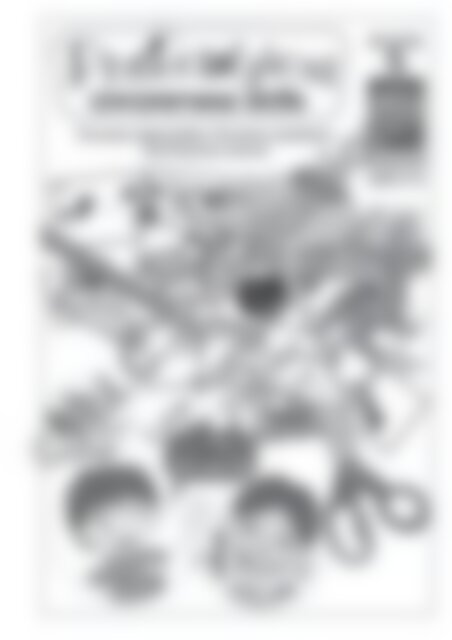RIC-6976 Phonological awareness skills Book 5 p1-23
You also want an ePaper? Increase the reach of your titles
YUMPU automatically turns print PDFs into web optimized ePapers that Google loves.
<strong>Phonological</strong> <strong>awareness</strong> <strong>skills</strong> (<strong>Book</strong> 5)<br />
Published by R.I.C. Publications ® 2018<br />
Copyright © R.I.C. Publications ® 2018<br />
ISBN 978-1-925698-56-5<br />
<strong>RIC</strong>– <strong>6976</strong><br />
Titles in this series:<br />
<strong>Phonological</strong> <strong>awareness</strong> <strong>skills</strong> (<strong>Book</strong> 1)<br />
Auditory discrimination, Rhyming and Alliteration<br />
<strong>Phonological</strong> <strong>awareness</strong> <strong>skills</strong> (<strong>Book</strong> 2)<br />
Segmentation and syllabification, and Blending<br />
<strong>Phonological</strong> <strong>awareness</strong> <strong>skills</strong> (<strong>Book</strong> 3)<br />
Phoneme matching and Phoneme isolation<br />
<strong>Phonological</strong> <strong>awareness</strong> <strong>skills</strong> (<strong>Book</strong> 4)<br />
Phoneme completion, and Phoneme addition and deletion<br />
<strong>Phonological</strong> <strong>awareness</strong> <strong>skills</strong> (<strong>Book</strong> 5)<br />
Phoneme segmentation, Phoneme substitution and Phoneme reversal<br />
All material identified by is material subject to copyright under the<br />
Copyright Act 1968 (Cth) and is owned by the Australian Curriculum,<br />
Assessment and Reporting Authority 2018.<br />
For all Australian Curriculum material except elaborations: This is an<br />
extract from the Australian Curriculum.<br />
Elaborations: This may be a modified extract from the Australian<br />
Curriculum and may include the work of other authors.<br />
Disclaimer: ACARA neither endorses nor verifies the accuracy of the<br />
information provided and accepts no responsibility for incomplete or<br />
inaccurate information.<br />
In particular, ACARA does not endorse or verify that:<br />
• The content descriptions are solely for a particular year and subject;<br />
• All the content descriptions for that year and subject have been used;<br />
and<br />
• The author’s material aligns with the Australian Curriculum content<br />
descriptions for the relevant year and subject.<br />
You can find the unaltered and most up to date version of this material at<br />
http://www.australiancurriculum.edu.au/<br />
This material is reproduced with the permission of ACARA.<br />
Copyright Notice<br />
A number of pages in this book are<br />
worksheets. The publisher licenses the<br />
individual teacher who purchased this<br />
book to photocopy these pages to hand<br />
out to students in their own classes.<br />
Except as allowed under the Copyright Act<br />
1968, any other use (including digital and<br />
online uses and the creation of overhead<br />
transparencies or posters) or any use by<br />
or for other people (including by or for<br />
other teachers, students or institutions)<br />
is prohibited. If you want a licence to<br />
do anything outside the scope of the<br />
BLM licence above, please contact the<br />
Publisher.<br />
This information is provided to clarify the<br />
limits of this licence and its interaction<br />
with the Copyright Act.<br />
For your added protection in the case of<br />
copyright inspection, please complete the<br />
form below. Retain this form, the complete<br />
original document and the invoice or<br />
receipt as proof of purchase.<br />
Name of Purchaser:<br />
Date of Purchase:<br />
Supplier:<br />
School Order# (if applicable):<br />
Signature of Purchaser:<br />
Internet websites<br />
In some cases, websites or specific URLs may be recommended. While these are checked and rechecked at the time of publication,<br />
the publisher has no control over any subsequent changes which may be made to webpages. It is strongly recommended that the<br />
class teacher checks all URLs before allowing students to access them.<br />
View all pages online<br />
PO Box 332 Greenwood Western Australia 6924<br />
Website: www.ricpublications.com.au<br />
Email: mail@ricpublications.com.au
Foreword<br />
The five books in the <strong>Phonological</strong> <strong>awareness</strong> <strong>skills</strong> series were<br />
developed to assist early childhood teachers develop these<br />
important <strong>skills</strong> with their children.<br />
The majority of the games and activities in this series of units<br />
are hands-on and oral, catering for pre-reading children. They<br />
are supported by teacher background information, including<br />
suggestions for teaching each skill, full instructions and all resources<br />
for each game and activity, additional resource worksheets and<br />
assessments. Literature and website links are also provided where<br />
applicable.<br />
These black and white hardcover books are also offered as fullcolour<br />
individual digital downloadable units.<br />
The <strong>skills</strong> in the books are presented in developmental order, so<br />
those in <strong>Book</strong> 1 should be completed before those in <strong>Book</strong> 5.<br />
Levels of phonological <strong>awareness</strong><br />
word<br />
The books in the series include:<br />
<strong>Book</strong> 1—Auditory discrimination, Rhyming and Alliteration<br />
<strong>Book</strong> 2—Segmentation and syllabification, and Blending<br />
<strong>Book</strong> 3—Phoneme matching and Phoneme isolation<br />
<strong>Book</strong> 4—Phoneme completion, and Phoneme addition and deletion<br />
<strong>Book</strong> 5—Phoneme segmentation, Phoneme substitution and Phoneme reversal<br />
syllable<br />
onset and rime<br />
phoneme<br />
Contents<br />
Teacher background information.......... iv–viii<br />
About the games and activity pages........ iv<br />
How to use the games and activities.........v<br />
Suggested mastery of <strong>skills</strong> table..............v<br />
Curriculum links.....................................vi–vii<br />
Assessing phonological<br />
<strong>awareness</strong> <strong>skills</strong>......................................... viii<br />
Phoneme segmentation .......................... 1–58<br />
Teacher notes...........................................1–2<br />
Pre-test..........................................................3<br />
Games, activities and resources...........4–56<br />
Assessment.......................................... 57–58<br />
Phoneme substitution...........................59–153<br />
Teacher notes...................................... 59–60<br />
Pre-test....................................................... 61<br />
Games, activities and resources...... 62–151<br />
Assessment......................................152–153<br />
Phoneme reversal............................... 154–214<br />
Teacher notes..................................154–155<br />
Pre-test..................................................... 156<br />
Games, activities and resources....157–212<br />
Assessment......................................213–214<br />
Assessing the three <strong>skills</strong>....................215–216<br />
Class recording sheet.................................. 217<br />
www.ricpublications.com.au ISBN 978-1-925698-56-5 PHONOLOGICAL AWARENESS SKILLS (<strong>Book</strong> 5) iii
TEACHER BACKGROUND INFORMATION<br />
The general term ‘phonological <strong>awareness</strong>’ includes phonemic <strong>awareness</strong> of sounds, words, syllables<br />
and rhyme. All phonological and phonemic <strong>awareness</strong> <strong>skills</strong> are learnt orally. Children need the ability<br />
to identify and work with the sounds of spoken language in order to make sense of sound–symbol<br />
relationships.<br />
About the games/activities pages<br />
The majority of the games and activities in this series of units are hands-on and oral, catering for prereading<br />
children. However, some activities involve sound–symbol relationships so letters and written<br />
work are included. This caters for younger children who need extension and older children who need<br />
remediation, consolidation, reinforcement or revision of <strong>skills</strong>.<br />
Games and activities without resources are suitable for lesson breaks and ‘attention-grabbing’ games.<br />
The 12 different <strong>skills</strong> are presented in developmental order. The first skill—auditory discrimination—is<br />
the most basic, but undervalued skill; while the twelfth—phoneme reversal—is the most complex skill<br />
and harder to master.<br />
The <strong>skills</strong> are: auditory discrimination, rhyming, alliteration, segmentation and syllabification, and<br />
blending. The following <strong>skills</strong> involve manipulating phonemes: phoneme matching, phoneme<br />
isolation, phoneme completion, phoneme addition and deletion, phoneme segmentation, phoneme<br />
substitution and phoneme reversal.<br />
• Each skill has a number of different components. Games and activities for each component are<br />
provided together. An objective down the side of each game/activity states which component is<br />
covered by the game/activity.<br />
For example, rhyming has three main components: discriminate rhymes between words (i.e. tell<br />
whether or not two spoken words rhyme); discriminate rhymes in context including listening to<br />
songs, poems, or nursery rhymes and find the rhymes; and produce rhymes.<br />
The title of the<br />
game/activity<br />
is given<br />
ACTIVITY 6: Phoneme phone segmenting<br />
A phonic phone is needed to complete this activity. Buy a set of whisper phones<br />
or make your own using the instructions at .<br />
Phonic phones amplify sounds, making it easier for the child to<br />
hear them.<br />
The children will also need the picture cards on pages 27—30<br />
and counters or markers. The game is played in pairs.<br />
The first child chooses a picture card. The second child says<br />
the word represented by the picture and orally segments the<br />
sounds in the word into the phonic phone. For example, if the<br />
picture shows a hat, the child says /h/ /a/ /t/. The first child<br />
places a counter for each phoneme on the card. The children<br />
then swap roles.<br />
This activity can also be used with any word given by the teacher or adult helper and<br />
the Elkonin boxes on page 31.<br />
ANSWERS:<br />
Page 27: axe–/a/ /x/; sun–/s/ /u/ /n/; bag–/b/ /a/ g/; snake–/s/ /n/ /a/ /k/; cow–/c/ /ow/; tea–/t/ /ea/<br />
Page 28: fish–/f/ /i/ /sh/; two–/t/ /oo/; lips–/l/ /i/ /p/ /s/; bib–/b/ /i/ /b; tie–/t/ /ie/; pig–/p/ /i/ /g/<br />
Page 29: house–/h/ /ou/ /s; hay–/h/ /ay/; cap–/c/ /a/ /p/; mat–/m/ /a/ /t/; clock–/c/ /l/ /o/ /ck/; plug–/p/ /l/ /u/ /g/<br />
Page 30: train–/t/ /r/ /ai/ /n/; fan–/f/ /a/ /n/; ant–/a/ /n/ /t/; hut–/h/ /u/ /t/; chin–/ch/ /i/ /n/; key–/k/ /ee<br />
Full instructions<br />
and reference<br />
to any resources<br />
needed are stated<br />
The skill<br />
component<br />
is stated<br />
• Isolate the separate sounds in words<br />
An image links<br />
to the resources<br />
needed. It also<br />
helps explain<br />
what the children<br />
are expected to do<br />
• All games/activities are titled and reference is made to the pages on which any required resources<br />
are found.<br />
• Full instructions describe the game and the number of children involved. Where spoken words are<br />
required, a list of words is provided.<br />
• Answers are provided where relevant.<br />
• Images on the game/activity reflect the resources required.<br />
iv<br />
PHONOLOGICAL AWARENESS SKILLS (<strong>Book</strong> 5) ISBN 978-1-925698-56-5 www.ricpublications.com.au
How to use the games and activities<br />
• All games and activities can be printed off onto cardboard, laminated, cut into A5 cards<br />
and stored in a box for easy access. Alternatively, the sheets may be printed off and<br />
placed in a plastic sleeve and stored in an A4 folder. Any full-colour resources can be<br />
photocopied, laminated and stored with them.<br />
• All activities are directed by a teacher or adult helper, so full instructions are given,<br />
including a script (where applicable) and a list of words to use. The children are not<br />
expected to read the words, although some may be included to clarify a picture so the<br />
correct word is generated, or to extend more capable children.<br />
• All resources should be collected and prepared before commencing a game or activity.<br />
Some games require sports equipment like beanbags, buckets, hoops or a hopscotch<br />
frame. Others require cards or game boards to be made.<br />
• Teachers or adult helpers should read all instructions and understand what the child is<br />
expected to do before starting an activity.<br />
• Some activities have resource worksheets to consolidate the concept and to engage<br />
children who like written work like ‘big kids’.<br />
Suggested mastery of <strong>skills</strong> table<br />
Age Skill Skill typically mastered<br />
4 Auditory discrimination<br />
4–5 Rhyming<br />
4–5 Alliteration<br />
TEACHER BACKGROUND INFORMATION<br />
4–5 Segmentation and syllabification<br />
5–6 Blending<br />
• Sentence segmentation<br />
• Syllable segmentation<br />
• Syllable blending<br />
• Phoneme blending (onset/rime)<br />
• Phoneme blending (all phonemes)<br />
5–6 Phoneme matching<br />
5–6 Phoneme isolation<br />
5–6 Phoneme completion<br />
6–7 Phoneme addition and deletion<br />
• Syllable deletion<br />
• Initial and final sound deletion<br />
6–7 Phoneme segmentation<br />
7–8 Phoneme substitution<br />
7–8 Phoneme reversal<br />
www.ricpublications.com.au ISBN 978-1-925698-56-5 PHONOLOGICAL AWARENESS SKILLS (<strong>Book</strong> 5) v
CUR<strong>RIC</strong>ULUM LINKS<br />
The phonological <strong>awareness</strong> <strong>skills</strong> presented in this series of units cover a range of age groups and levels.<br />
To account for these, links to both the Early Years Learning Framework and Australian Curriculum have been<br />
provided.<br />
The Early Years Learning Framework (EYLF)<br />
The games and activities in this series incorporate the following outcomes:<br />
Outcome 1: Children have a strong sense of identity<br />
Children develop their emerging autonomy, interdependence, resilience and sense of urgency. For example, when they<br />
increasingly cooperate and work collaboratively with others.<br />
Outcome 2: Children are connected with and contribute to their world<br />
Children develop a sense of belonging to groups and communities and an understanding of the reciprocal rights and<br />
responsibilities necessary for active community participation. For example, when they broaden their understanding of the world<br />
in which they live; listen to others’ ideas and respect different ways of being and doing; use play to investigate, project and<br />
explore new ideas; and increasingly cooperate and work with others.<br />
Outcome 3: Children have a strong sense of wellbeing<br />
Children become strong in their social and emotional wellbeing. For example, when they increasingly cooperate and work<br />
collaboratively with others; recognise their individual achievement; and recognise the contributions they make to shared<br />
projects and experience.<br />
Children take increasing responsibility for their own health and physical wellbeing. For example, when they manipulate<br />
equipment and manage tools with increasing competence and skill.<br />
Outcome 4: Children are confident and involved learners<br />
Children develop dispositions for learning such as curiosity, cooperation, confidence, creativity, commitment, enthusiasm,<br />
persistence, imagination and reflexivity. For example, when they are curious and enthusiastic participants in their learning; use<br />
play to investigate, imagine and explore ideas; and participate in a variety of rich and meaningful inquiry-based experiences.<br />
Children develop a range of <strong>skills</strong> and processes such as problem-solving, inquiry, experimentation, hypothesising, researching<br />
and investigating. For example, when they apply a wide variety of thinking strategies to engage with situations and solve<br />
problems.<br />
Children transfer and adapt what they have learned from one context to another. For example, when they make connections<br />
between experiences, concepts and processes; and use the processes of play, reflection and investigation to solve problems.<br />
Children resource their own learning through connecting with people, places, technologies and natural and processed materials.<br />
For example, when they use their senses to explore natural and built environments; explore the purpose and function of a<br />
range of tools, media, sounds and graphics; manipulate resources to investigate, take apart, assemble, invent and construct;<br />
use information and communication technologies (ICT) to investigate and problem-solve; and explore ideas and theories using<br />
imagination, creativity and play.<br />
Outcome 5: Children are effective communicators<br />
Children interact verbally and non-verbally with others for a range of purposes. For example, when they engage in enjoyable<br />
interactions using verbal and non-verbal language; contribute their ideas and experiences in play, small- and large-group<br />
discussions; interact with others to explore ideas and concepts, clarify and challenge thinking, negotiate, and share new<br />
understandings; convey and construct messages with purpose and confidence, building on literacies of home/family and the<br />
broader community; exchange ideas, feelings and understandings using language and representations in play; and express<br />
ideas and feelings and understand and respect the perspectives of others.<br />
Children engage with a range of texts and gain meaning from these texts. For example, when they listen and respond to sounds<br />
and patterns in speech, stories and rhymes in context; sing and chant rhymes, jingles and songs; and begin to understand key<br />
literacy and numeracy concepts and processes, such as the sounds of language, letter–sound relationships, concepts of print and<br />
the ways texts are structured.<br />
vi<br />
PHONOLOGICAL AWARENESS SKILLS (<strong>Book</strong> 5) ISBN 978-1-925698-56-5 www.ricpublications.com.au
CUR<strong>RIC</strong>ULUM LINKS<br />
The Early Years Learning Framework (EYLF)<br />
Outcome 5: Children are effective communicators (continued)<br />
Children begin to understand how symbols and pattern systems work. For example, when they develop an understanding that<br />
symbols are a powerful means of communication and that ideas, thoughts and concepts can be represented through them;<br />
begin to be aware of the relationships between oral, written and visual representations; and listen and respond to sounds and<br />
patterns in speech, stories and rhyme.<br />
Children use information and communication technologies to access information, investigate ideas and represent their thinking.<br />
For example, when they engage with technology for fun and to make meaning.<br />
The Early Years Learning Framework (PDF). Australian Government Department of Education and Training. Retrieved 13 June 2018.<br />
Australian Curriculum English<br />
Foundation<br />
Phonics and word knowledge<br />
• Recognise and generate rhyming words, alliteration patterns, syllables and sounds (phonemes) in spoken words<br />
(ACELA1439)<br />
• Recognise and name all upper and lower case letters (graphemes) and know the most common sound that each letter<br />
represents (ACELA1440)<br />
• Understand how to use knowledge of letters and sounds including onset and rime to spell words (ACELA1438)<br />
• Know how to read and write some high-frequency words and other familiar words (ACELA1817)<br />
• Understand that words are units of meaning and can be made of more than one meaningful part (ACELA1818)<br />
• Segment sentences into individual words and orally blend and segment onset and rime in single syllable spoken words, and<br />
isolate, blend and manipulate phonemes in single syllable words (ACELA1819)<br />
• Write consonant-vowel-consonant (CVC) words by representing some sounds with the appropriate letters, and blend sounds<br />
associated with letters when reading CVC words (ACELA1820)<br />
Year 1<br />
Phonics and word knowledge<br />
• Manipulate phonemes in spoken words by addition, deletion and substitution of initial, medial and final phonemes to<br />
generate new words (ACELA1457)<br />
• Use short vowels, common long vowels, consonant digraphs and consonant blends when writing, and blend these to read<br />
single syllable words (ACELA1458)<br />
• Understand how to spell one and two syllable words with common letter patterns (ACELA1778)<br />
Year 2<br />
Phonics and word knowledge<br />
• Orally manipulate more complex sounds in spoken words through knowledge of blending and segmenting sounds, phoneme<br />
deletion and substitution in combination with use of letters in reading and writing (ACELA1474)<br />
www.ricpublications.com.au ISBN 978-1-925698-56-5 PHONOLOGICAL AWARENESS SKILLS (<strong>Book</strong> 5) vii
ASSESSING PHONOLOGICAL AWARENESS SKILLS<br />
<strong>Phonological</strong> <strong>awareness</strong> <strong>skills</strong> play an important part in early childhood<br />
learning. It is therefore essential to screen children as early as possible<br />
so that any gaps in education, misconceptions or weaknesses can<br />
be remedied quickly. Learning difficulties should be detected and<br />
rectified as early as possible so that issues of poor self-esteem do not<br />
develop.<br />
<strong>Phonological</strong> <strong>awareness</strong> is a strong predictor of literacy development<br />
and the <strong>Phonological</strong> pre-tests provide an overview of pre- reading<br />
<strong>skills</strong> needed for literacy development.<br />
Levels of phonological <strong>awareness</strong><br />
word<br />
syllable<br />
onset and rime<br />
phoneme<br />
PRE-TESTING AND POST-TESTING<br />
It is essential to assess young children on their phonological <strong>awareness</strong> <strong>skills</strong> before introducing<br />
specific ones.<br />
<strong>Phonological</strong> <strong>awareness</strong> testing should occur early at kindergarten or prep level, and monitoring of<br />
the children’s progress should continue throughout the year.<br />
Both pre- and post-testing have been provided in this book. All tests should be administered on a<br />
one-to-one basis.<br />
The post- tests provided in this book are comprehensive and have a greater degree of difficulty,<br />
assessing a child’s understanding of phonological <strong>awareness</strong> <strong>skills</strong>. In-depth assessments are<br />
provided at the end of each skill section. An assessment covering all <strong>skills</strong> in the book is provided on<br />
pages 215–216. Once gaps in learning or misconceptions have been identified, teachers can utilise<br />
the information to further assist children experiencing learning difficulties.<br />
Full instructions are provided and no resources are required to carry out the testing. A section is<br />
provided for teachers to make comments about children’s responses.<br />
Teachers should use their own initiative about when to stop the testing if students are confused,<br />
frustrated or find the test too easy (when it is very obvious they have mastered the skill).<br />
A class recording sheet is provided on page 217 for the pre-test and for the post-test. More than<br />
one copy of the checklist may need to be printed to cover all the children in the class. Options for<br />
colouring the results are suggested to make it easier to view results at a glance.<br />
To administer the assessments, teachers or adult helpers will need:<br />
• one set of assessment task sheets for each child<br />
• three simple sound items for the auditory discrimination task<br />
• class recording sheet<br />
Administering the tests:<br />
• Assess children individually.<br />
• Give clear instructions (these are included).<br />
• Assess in an area where there are few distractions.<br />
• Model examples so children have a clear understanding of the tasks.<br />
• Record responses and comment about automaticity of answers.<br />
• Work through each section until the children have four consecutive incorrect answers.<br />
viii<br />
PHONOLOGICAL AWARENESS SKILLS (<strong>Book</strong> 5) ISBN 978-1-925698-56-5 www.ricpublications.com.au
SKILL 10: PHONEME SEGMENTATION<br />
TEACHER NOTES<br />
What is phoneme segmentation?<br />
Phoneme segmentation is the process of identifying and breaking a<br />
word into each separate sound in the correct sequence. In essence,<br />
children identify the individual sounds in words.<br />
What does phoneme segmentation involve?<br />
Phoneme segmentation involves:<br />
• ‘stretching’ out words by saying them slowly and emphasising<br />
each sound<br />
• isolating the separate sounds in words<br />
• counting the separate sounds in words<br />
• segmenting for spelling<br />
Why is phoneme segmentation important?<br />
Phoneme segmentation is a skill that directly links relates to the<br />
ability to spell. When children can stretch out words, segment words<br />
into individual sounds and have learnt the letters that represent<br />
these sounds, they can write them in order to spell words.<br />
Levels of phonological <strong>awareness</strong><br />
word<br />
syllable<br />
onset and rime<br />
phoneme<br />
The same process links segmenting sounds and reading.<br />
What do I need to remember when doing phoneme segmentation?<br />
• Teachers need to demonstrate this skill, but they need to make sure that they do not stretch out the<br />
sounds so much that the sounds cannot connect them back to the word.<br />
• It is important for children to understand the difference between phonemes and letters. The<br />
number of phonemes in a word does not necessarily equal the number of letters. For example, if<br />
the word boat is segmented into phonemes, they are /b/ /oa/ /t/—three sounds, where as, there are<br />
four letters in the word.<br />
• Some letter sounds can be lengthened and held for a length of time. Others, however, when<br />
lengthened, may change the sound.<br />
Sounds that can be elongated and held<br />
continuously<br />
Sounds that CANNOT be elongated and held<br />
continuously<br />
a, e, f, i, l, m, n, o, r, s, u, v, w, y, z b, c, d, g, h, j, k, p, q, t, x<br />
These sounds are easier to blend so instruction<br />
should commence with these.<br />
Use words such as fan, sum, fuzz etc.<br />
Hold for 1 or 2 seconds and blend smoothly with<br />
the next sound.<br />
These sounds are more different to blend<br />
without changing the sound, so introduce these<br />
gradually.<br />
Say the sound once only, pause for 1 or 2<br />
seconds, then say the next sound elongating this<br />
sound for 1 or 2 seconds<br />
www.ricpublications.com.au ISBN 978-1-925698-56-5 PHONOLOGICAL AWARENESS SKILLS (<strong>Book</strong> 5) 1
SKILL 10: PHONEME SEGMENTATION<br />
What is the best way to support children as they learn about phoneme segmentation?<br />
• As always, the most effective instruction method for any reading skill is modelling. Model<br />
segmenting in a number of different ways, always being slow, clear and correct. Increase the speed<br />
of the sounds delivery until the children become proficient.<br />
• Always provide plenty of practice segmenting sounds orally before introducing the letters that<br />
represent the separate sounds articulated.<br />
• Revise segmenting sentences into words, segmenting compound words, segmenting words into<br />
syllables and segmenting words into onset and rime, before introducing the skill of segmenting<br />
words into phonemes. This ensures children move from breaking down larger units to the smallest<br />
units of sounds. The unit on segmentation and syllabification provides an abundance of activities to<br />
practice these <strong>skills</strong>.<br />
• Always use plenty of visual support, pointing to pictures when learning segmenting. Visual<br />
representations aid memory of sounds.<br />
• Introduce letters for sounds only when you feel the children are ready to grasp the concept.<br />
• When slowly sounding out a word such as ‘rrrruuunnnn’, point to each letter as each sound is<br />
pronounced.<br />
• Ensure that all senses are engaged, as most children benefit from hands-on activities. Counters and<br />
markers should be used, or the children can ‘run’ a small plastic car over the letters on a card as<br />
they say the sounds slowly.<br />
• The use of phoneme segmentation boxes such as Elkonin boxes, like those above, provide a good<br />
visual representation for children as they learn to segment words into phonemes.<br />
2<br />
PHONOLOGICAL AWARENESS SKILLS (<strong>Book</strong> 5) ISBN 978-1-925698-56-5 www.ricpublications.com.au
PHONOLOGICAL AWARENESS PRE-TEST<br />
Phoneme segmentation<br />
Say these instructions to the child:<br />
I’m going to say a word slowly. I want you to tell me the sounds<br />
you hear in the word.<br />
Use the following as an example:<br />
Say: in What sounds do you hear? /i/ /n/<br />
Say the following instructions:<br />
1. at What sounds do you hear? /a/ /t/<br />
2. up What sounds do you hear? /u/ /p/<br />
3. is What sounds do you hear? /i/ /s/<br />
4. go What sounds do you hear? /g/ /o/<br />
5. off What sounds do you hear? /o/ /f/<br />
Comments<br />
Total:<br />
www.ricpublications.com.au ISBN 978-1-925698-56-5 PHONOLOGICAL AWARENESS SKILLS (<strong>Book</strong> 5) 3
PHONEME SEGMENTATION GAMES AND ACTIVITIES<br />
ACTIVITY 1: Hands-on segmenting<br />
The children stand, spaced some distance apart, and use their hands to represent how<br />
words can be ‘stretched out’.<br />
The children place their hands together straight out in front of them. The teacher or<br />
adult helper says a word and then repeats it slowly, stretching out the phonemes in the<br />
word. For each sound heard, the children move their hands apart until the last sound is<br />
stated.<br />
Once the children understand how to ‘stretch out’ words with their hands, selected<br />
children can be chosen to demonstrate how to ‘stretch out’ a word of their own. When<br />
proficient, the children can be given their own word to ‘stretch out’.<br />
• Stretch out words<br />
ACTIVITY 2: Silly segmenting<br />
Use putty or playdough for this activity.<br />
This activity is similar to the one above.<br />
Each child is given a ball of putty or playdough which they roll into a fat ‘sausage’<br />
shape.<br />
The teacher says a word and repeats it slowly, stretching out the sounds. The children<br />
stretch out the putty or playdough each time they hear a new sound in the word.<br />
Start with words with a small number of phonemes then increase the number until the<br />
putty or playdough is so stretched it breaks.<br />
After each word has been ‘stretched out’, the children can roll the putty or playdough<br />
back into a fat sausage shape.<br />
• Stretch out words<br />
4<br />
PHONOLOGICAL AWARENESS SKILLS (<strong>Book</strong> 5) ISBN 978-1-925698-56-5 www.ricpublications.com.au
PHONEME SEGMENTATION GAMES AND ACTIVITIES<br />
• Stretch out words • Stretch out words<br />
ACTIVITY 3: ‘Stretched out’ word cards<br />
Use the divided cards on pages 17–<strong>23</strong> to play this game.<br />
Each card must be cut up into the correct number of<br />
phonemes in the word. Cards should be printed onto<br />
cardboard and laminated for durability before using.<br />
The cards provided are divided into the number of<br />
phonemes in each word represented by an image.<br />
The cards for words with the same number of phonemes<br />
should be stored together in separate ziplock bags. One<br />
bag will contain pictures for all the words with 2 phonemes,<br />
another will hold all the 3-phoneme words, a third will hold all<br />
the 4-phoneme words and the last will hold the 5-phoneme<br />
words.<br />
The game may be played individually, in pairs or in small groups.<br />
The cut-apart cards are mixed up and the child/children move the parts together to<br />
complete the picture and say the complete word. Then they move the pieces apart<br />
segmenting the word. Ensure the children point to each part (sound) as they say the<br />
sounds that make up each word.<br />
Words are provided for more capable children who want to read them.<br />
ACTIVITY 4: Phoneme jumping (or hopping)<br />
Place three different-coloured small hoops on the floor or ground. Say a two- or threephoneme<br />
word aloud and have each child say the sounds they hear in the word as they<br />
jump into each hoop.<br />
Different-coloured hoops tell the child that each sound is a different one.<br />
Select from the words on the phoneme word list on page 24.<br />
This activity is good to use with words that are difficult to represent visually, such as am,<br />
at, is etc.<br />
Progress to four- or five-phoneme<br />
words when the children have<br />
demonstrated their capability.<br />
feet<br />
bike<br />
bed<br />
sun<br />
web<br />
road<br />
www.ricpublications.com.au ISBN 978-1-925698-56-5 PHONOLOGICAL AWARENESS SKILLS (<strong>Book</strong> 5) 5
PHONEME SEGMENTATION GAMES AND ACTIVITIES<br />
ACTIVITY 5: Egg carton game<br />
Use the pictures on pages 25 and 26 to play this game, individually, in pairs or in small<br />
groups. Photocopy the pictures onto cardboard, laminate them and cut them out. Glue<br />
them inside an egg carton with one picture placed inside each cup.<br />
The child places a counter or button inside the egg carton, closes the lid firmly,<br />
then shakes the egg carton. The egg carton is opened and the child finds where the<br />
counter or button has landed. The child looks at the picture beneath the counter/<br />
button and names the picture. Then the child segments the word into phonemes. The<br />
next child then has a turn. Continue until all the words naming the pictures have been<br />
segmented.<br />
The words depicted are:<br />
Pictures 1: duck, nail, sack, cake, rain, jam,<br />
van, hen, knife, zip, goat, log, lock, cow,<br />
mug, ham, bed, leg, jet, pen, bib, bag, hat,<br />
chin<br />
Pictures 2: mat, rat, dam, ram, tap, bat, peg,<br />
ten, net, lid, pig, dig, wig, bin, fin, dog, pin,<br />
mop, top, cot, jug, tub, sun, hut<br />
Enough pictures have been provided to fill<br />
four different egg cartons.<br />
• Stretch out words<br />
ACTIVITY 6: Phoneme phone segmenting<br />
A phonic phone is needed to complete this activity. Buy a set of whisper phones<br />
or make your own using the instructions at .<br />
Phonic phones amplify sounds, making it easier for the child to<br />
hear them.<br />
The children will also need the picture cards on pages 27—30 and<br />
counters or markers. The game is played in pairs.<br />
The first child chooses a picture card. The second child says the<br />
word represented by the picture and orally segments the sounds<br />
in the word into the phonic phone. For example, if the picture<br />
shows a hat, the child says /h/ /a/ /t/. The first child places a<br />
counter for each phoneme on the card. The children then swap<br />
roles.<br />
This activity can also be used with any word given by the teacher or adult helper and<br />
the Elkonin boxes on page 31.<br />
ANSWERS:<br />
Page 27: axe–/a/ /x/; sun–/s/ /u/ /n/; bag–/b/ /a/ g/; snake–/s/ /n/ /a/ /k/; cow–/c/ /ow/; tea–/t/ /ea/<br />
Page 28: fish–/f/ /i/ /sh/; two–/t/ /oo/; lips–/l/ /i/ /p/ /s/; bib–/b/ /i/ /b; tie–/t/ /ie/; pig–/p/ /i/ /g/<br />
Page 29: house–/h/ /ou/ /s; hay–/h/ /ay/; cap–/c/ /a/ /p/; mat–/m/ /a/ /t/; clock–/c/ /l/ /o/ /ck/; plug–/p/ /l/ /u/ /g/<br />
Page 30: train–/t/ /r/ /ai/ /n/; fan–/f/ /a/ /n/; ant–/a/ /n/ /t/; hut–/h/ /u/ /t/; chin–/ch/ /i/ /n/; key–/k/ /ee<br />
• Isolate the separate sounds in words<br />
6<br />
PHONOLOGICAL AWARENESS SKILLS (<strong>Book</strong> 5) ISBN 978-1-925698-56-5 www.ricpublications.com.au
PHONEME SEGMENTATION GAMES AND ACTIVITIES<br />
• Isolate the separate sounds in words<br />
ACTIVITY 7: Break it up<br />
This activity requires no equipment.<br />
Tell the children that you are going to say a word and they have to break it up into<br />
sounds.<br />
Give some examples, beginning with simple CV, VC or CVC words such as me, nut or<br />
game. Demonstrate how to break up the word. For example, /m/ /e/, /n/ /u/ /t/<br />
and /g/ /a/ /me/.<br />
Ask the children to clap, tap their<br />
knees, touch their head, stamp<br />
their feet, click their fingers or tap hot<br />
a triangle each time a new sound is<br />
stated in a word.<br />
/h/ /o/ /t/<br />
Once the children can segment<br />
simple words, progress to words<br />
with four or five phonemes.<br />
CLAP!<br />
CLAP!<br />
CLAP!<br />
• Isolate the separate sounds in words<br />
ACTIVITY 8: What sounds do you hear?<br />
Use the phoneme cards on pages 32–35 to help the children practise isolating<br />
phonemes in words.<br />
The children are told the number of<br />
phonemes in each word represented by a<br />
picture and they have to say the phonemes.<br />
They point to the picture, say the word,<br />
segment it and say the sounds, making sure<br />
they have the correct number to match the<br />
card.<br />
Teachers may wish to provide children with<br />
counters, markers or pegs to clip to each card to<br />
represent each phoneme in the word.<br />
The following images are depicted:<br />
1 — bee, key, boy, pea, pie, toe, cow, ape<br />
2 — pan, hat, zip, jug, dog, jet, tap, sheep<br />
3 — tree, leaf, shell, cake, kite, mouse, bike, bone<br />
4 — lamp, snake, tent, clock, snail, train, crab, frog<br />
www.ricpublications.com.au ISBN 978-1-925698-56-5 PHONOLOGICAL AWARENESS SKILLS (<strong>Book</strong> 5) 7
PHONEME SEGMENTATION GAMES AND ACTIVITIES<br />
ACTIVITY 9: Push and slide<br />
Use any readily-available manipulatives for this activity. Counters, beads, blocks, craft<br />
sticks etc. are all suitable.<br />
If dealing with three-phoneme words, each child will need three manipulatives;<br />
if dealing with four- or five-phoneme words, the children will need four or five<br />
manipulatives. To challenge the children, provide six manipulatives so the children<br />
have to think about how many to move.<br />
The children have their manipulatives lined up in front of them. The teacher or adult<br />
helper says a word and the child pushes or slides one manipulative forward for each<br />
phoneme heard in the word given. The manipulatives will form a new row towards the<br />
front.<br />
Ensure the children are competent<br />
isolating the phonemes for two- or<br />
three-phoneme words before moving<br />
to words with more phonemes.<br />
• Isolate the separate sounds in words<br />
ACTIVITY 10: Puppets<br />
Provide individual children with puppets with mouths that open and close.<br />
Sock puppets may be used or the children can make their own puppet using the<br />
templates on pages 36–37. The puppet template should be coloured, cut out and<br />
glued to a folded paper plate. The children may wish to add extra details such as<br />
material bows, clothing etc. to brighten their puppet. Give the children a word with<br />
between two and five phonemes. The children open and close the puppet’s mouth for<br />
each sound in the word.<br />
The children may need to be shown how to use the puppet<br />
since many will simply try to ‘grab’ other children or objects<br />
using the mouth of the puppet rather than opening and<br />
closing the mouth to speak.<br />
Instructions for making simple sock puppets can be found at<br />
.<br />
Puppets like those at<br />
<br />
may also be used.<br />
• Isolate the separate sounds in words<br />
8<br />
PHONOLOGICAL AWARENESS SKILLS (<strong>Book</strong> 5) ISBN 978-1-925698-56-5 www.ricpublications.com.au
PHONEME SEGMENTATION GAMES AND ACTIVITIES<br />
• Isolate the separate sounds in words<br />
ACTIVITY 11: Animal names split up<br />
Use the animal cards on pages 38–40 to play<br />
this game.<br />
Photocopy, laminate and cut out the animal<br />
pictures.<br />
Form two teams of children. Use a six thrown<br />
on a dice or a tossed coin to decide which<br />
team starts.<br />
The first team member is shown an animal<br />
picture. He/She segments the animal name.<br />
If correct, the team gets one point. The first<br />
team member in the second team has a turn.<br />
The team with the most points at the end,<br />
when all animal pictures have been shown,<br />
wins.<br />
ACTIVITY 12: Phoneme walk<br />
Draw a number path on a pathway or concrete area of the playground covering the<br />
numbers 1 to 5. (Walk-on number lines are available commercially.) Alternatively,<br />
coloured masking or electrical tape may be stuck to the floor.<br />
The teacher or adult helper says a word, the child repeats the word slowly, then, when<br />
the word is segmented, walks on one number until all the phonemes in the word have<br />
been counted. The teacher asks ‘How many sounds?’ The child says the final number<br />
walked on to give a count of the number of sounds in the word.<br />
Repeat with a number of different words.<br />
• Count the separate sounds in words<br />
1<br />
2<br />
3<br />
4<br />
5<br />
www.ricpublications.com.au ISBN 978-1-925698-56-5 PHONOLOGICAL AWARENESS SKILLS (<strong>Book</strong> 5) 9
PHONEME SEGMENTATION GAMES AND ACTIVITIES<br />
ACTIVITY 13: Play those sounds!<br />
Provide the children with different musical instruments—triangles, bells, tambourines or<br />
castanets.<br />
The teacher or adult helper says a word with between 2 and 6 phonemes. The children<br />
‘stretch out’ the word and strike their instrument once for each new sound in the<br />
word.<br />
They count how many times they strike their instrument to identify the number of<br />
sounds in the word.<br />
Repeat with other words.<br />
To assist the children, select individual children to<br />
stand out the front like a conductor to count the<br />
number of ‘strikes’ in each word.<br />
• Count the separate sounds in words<br />
ACTIVITY 14: Counting sounds<br />
Provide each child with the tracking sheet from page 41. These can be photocopied<br />
and laminated for the children to use with wipe-off markers or counters.<br />
The teacher or adult helper says a word with between 2 and 6 phonemes. The child<br />
segments the word and draws a cross (or places a counter) in each box vertically to<br />
show how many phonemes are in the word, starting at the top and going down.<br />
When each word is completed, the child counts<br />
the number of phonemes in the word.<br />
Each new word occupies a different column.<br />
Demonstrate first using a copy on the<br />
whiteboard.<br />
The words in the lists on page 24 may be used.<br />
• Count the separate sounds in words<br />
10<br />
PHONOLOGICAL AWARENESS SKILLS (<strong>Book</strong> 5) ISBN 978-1-925698-56-5 www.ricpublications.com.au
PHONEME SEGMENTATION GAMES AND ACTIVITIES<br />
• Count the separate sounds in words<br />
ACTIVITY 15: Beanbag/Ball toss<br />
Use the tracking sheet on page 42 for this activity.<br />
The children will need beanbags or soft balls, and a<br />
basket or small hoop in which to throw them.<br />
The children look at the first picture on the tracking<br />
sheet, say the word, segment it into sounds and<br />
count how many sounds in the word. They write the<br />
number in the second column of the sheet.<br />
Then they throw one beanbag/ball in the container/<br />
hoop for each sound in the word. Each beanbag<br />
or ball earns the child one point, which the child<br />
records on the tracking sheet in the third column.<br />
When all six words have been completed, the child or an adult helper can help the<br />
child count the total number of points earned. (Each child may count out the correct<br />
number of counters for points earned and place these in a ziplock bag to help them<br />
count the total at the end.)<br />
A blank tracking sheet is provided on page 43 so teachers can create their own.<br />
ANSWERS:<br />
axe (2); bike (3); brick (4); rabbit (5); lamp (4); web (3)<br />
Bean bag/Ba l toss – Tracking sheet<br />
Word picture How many sounds? Points<br />
How many points altogether?<br />
• Count the separate sounds in words<br />
ACTIVITY 16: Graphing sounds in words<br />
This activity is similar to Activity 14. However, more fine motor <strong>skills</strong> and time are<br />
required.<br />
Each child will need a copy of the graphing sheet on page 44.<br />
The child looks at the picture at the bottom of each column,<br />
says the word, segments it into sounds, colours one box for<br />
each sound in the word and counts the number of sounds.<br />
Once completed, the child should make statements<br />
comparing words with more, less or the same number of<br />
sounds.<br />
For those children whose fine motor <strong>skills</strong> need developing,<br />
counters or markers may be used in the boxes instead of<br />
colouring.<br />
A blank template is provided on page 45 for teachers who<br />
would like to create their own or additional graphing sounds in words sheets.<br />
For more capable children or early finishers, ask them to draw a picture of an object<br />
from home or school, say the word, segment it into sounds and write the number of<br />
sounds next to the picture on the blank template.<br />
ANSWERS:<br />
book (3); toe (2); brush (4); house/home (3); monkey (5); pencil (6)<br />
6<br />
5<br />
4<br />
3<br />
2<br />
1<br />
www.ricpublications.com.au ISBN 978-1-925698-56-5 PHONOLOGICAL AWARENESS SKILLS (<strong>Book</strong> 5) 11
PHONEME SEGMENTATION GAMES AND ACTIVITIES<br />
ACTIVITY 17: Photograph name counts<br />
Some preparation is required to play this game in pairs.<br />
Take digital photographs of each of the children in the<br />
class. Print them in colour, glue onto cardboard, write the<br />
student’s name underneath, laminate them and cut them<br />
out.<br />
On the back of each card, write the number of sounds in<br />
each child’s name. Place the photographs in a box.<br />
The children will also need interlocking cubes such as<br />
Unifix cubes to represent the number of sounds in each name.<br />
J e s s i c a<br />
C a l e b<br />
The first child selects one photograph from the box.<br />
The second child names the child in the photograph. Child One taps the number of<br />
sounds in the child’s name and checks the back of the card to see if they are correct.<br />
The second child then makes an interlocking tower of blocks that matches the number<br />
of sounds in the name of the child in the photograph. The tower can be placed beside<br />
the photograph.<br />
The children swap roles until the time has elapsed or all photographs have been<br />
selected.<br />
• Count the separate sounds in words<br />
ACTIVITY 18: Sorting words by sound numbers<br />
Reuse the cards on pages 32—35 for this sound number sort. An additional page of<br />
pictures on cards is provided on page 47 for five-phoneme words.<br />
A plastic pocket chart is also required to complete this activity, which can be done by<br />
individuals, pairs or small groups.<br />
Print off the number cards on page 46 and place them along the top line of the pocket<br />
chart. These are the number headings.<br />
Hang the pocket chart securely. Place the phoneme picture cards in a stack facedown<br />
on the floor or table close by.<br />
The children take turns to select a picture card and name the object. The child<br />
segments the word into individual phonemes and counts the number. (They might like<br />
to tap out or clap the sounds to make it easier to count the number.)<br />
The picture card is then placed in the slot on the<br />
chart beneath the corresponding number.<br />
Continue until all picture cards have been<br />
selected.<br />
NOTE:<br />
The numbers two to five are the most common but teachers may<br />
extend the children by asking them to draw pictures or write<br />
words with one phoneme or six.<br />
2 3 4<br />
5<br />
• Count the separate sounds in words<br />
12<br />
PHONOLOGICAL AWARENESS SKILLS (<strong>Book</strong> 5) ISBN 978-1-925698-56-5 www.ricpublications.com.au
PHONEME SEGMENTATION GAMES AND ACTIVITIES<br />
• Count the separate sounds in words<br />
ACTIVITY 19: Hopscotch<br />
Use a modified hopscotch frame to help the<br />
children practise segmenting words into<br />
phonemes. This activity can be played in pairs or<br />
small groups.<br />
This activity can be used with words that are<br />
difficult to represent in pictures, although<br />
phoneme picture cards may be used if desired.<br />
Select from those on pages 32–35 and page 47.<br />
Say a word or ask the children to take turns<br />
to select a picture from a stack placed on the<br />
floor.<br />
6 6<br />
5<br />
4 4<br />
3<br />
2 2<br />
1<br />
The child says the word, segments it<br />
into phonemes and counts the number. The child then hops and jumps along the<br />
frame, saying each sound as they move from one number to the next. The action of<br />
segmenting can be repeated as the child returns to the start.<br />
The next child has a turn and this continues until all the picture cards or words have<br />
been used up.<br />
Some words with six phonemes include dinosaur, backpack, snowman, violin, domino,<br />
strand, strength, sprint, splint, script and scrimp.<br />
• Count the separate sounds in words<br />
ACTIVITY 20: Phoneme spin<br />
Re-use the picture cards of words with between two and five phonemes on<br />
pages 32–35 and page 47. The spinner is provided on page 48 and an optional<br />
recording sheet is on page 49.<br />
This game can be played in pairs or small groups.<br />
To play the game, select two of each of the different numbered phoneme picture<br />
cards—two pictures of words with two phonemes, two with three, two with four and two<br />
with five. Place these face up in 2 rows of four.<br />
The children take turns to spin the spinner to identify a number. They then select a<br />
picture showing a word with the corresponding number<br />
of phonemes. They say the word, and segment it into<br />
phonemes.<br />
The game continues with the next child taking a turn until all<br />
the cards have been selected.<br />
(If teachers wish to extend the activity, they can ask the<br />
children to use the recording sheet on page 49. The<br />
child draws a picture of the object selected in the box<br />
corresponding to the number of phonemes in the word.<br />
Additional sheets may need to be photocopied depending<br />
on the number of turns each child has.)<br />
www.ricpublications.com.au ISBN 978-1-925698-56-5 PHONOLOGICAL AWARENESS SKILLS (<strong>Book</strong> 5) 13
PHONEME SEGMENTATION GAMES AND ACTIVITIES<br />
ACTIVITY 21: Who has the most sounds?<br />
Reuse the picture cards of words with between two and five phonemes on<br />
pages 32–35 and page 47 to play this game in pairs.<br />
Shuffle the cards and place them face down in two piles on the floor or table. One pile<br />
is for each child.<br />
The children take turns to select a card from their pile, turn it over, name the picture,<br />
segment the words into phonemes and count them.<br />
After each child has taken a turn, the children work out who has the word with the most<br />
sounds. The child with the most sounds, keeps both cards.<br />
If both have the same number of cards, each child takes another turn until one wins<br />
the ‘hand’.<br />
Continue until all picture cards have<br />
been selected.<br />
The child with the most cards at the<br />
end is the winner.<br />
• Count the separate sounds in words<br />
ACTIVITY 22: Phoneme count<br />
Use the game boards on pages 50—53 to play this game in pairs. Counters are also<br />
needed.<br />
The children take turns to select a picture in any row on the game board. They name<br />
the picture, segment the word into sounds and count how many sounds are in the<br />
word. They then place the correct number of counters on top of the picture selected.<br />
When all pictures are covered in piles of<br />
counters, the children select three rows each<br />
to count up the total number of sounds in<br />
each row. The total should correspond to the<br />
number at the end of each row.<br />
A blank game board is provided on page 54.<br />
10<br />
11<br />
14<br />
11<br />
13<br />
13<br />
• Count the separate sounds in words<br />
14<br />
PHONOLOGICAL AWARENESS SKILLS (<strong>Book</strong> 5) ISBN 978-1-925698-56-5 www.ricpublications.com.au
PHONEME SEGMENTATION GAMES AND ACTIVITIES<br />
• Count the separate sounds in words<br />
ACTIVITY <strong>23</strong>: Segmenting circle<br />
The children will need a dice, the game board on page 55 and one counter each to<br />
play this game. This game can be played with between 2 and 5 players. One child will<br />
need to take on the role of judge.<br />
The children take turns to roll a dice to see who starts. (The child with the largest<br />
number goes first.) The child names the first picture, segments the phonemes in the<br />
word and says how many sounds there are.<br />
If correct, the child places their counter to<br />
mark their position. For each consecutive<br />
correct answer, players move forward with the<br />
aim to get to the finish.<br />
Enlarge the game board to a more<br />
appropriate size if desired, photocopy or glue<br />
onto cardboard and laminate for durability.<br />
A blank Segmenting circle game board is also<br />
provided on page 56 so that teachers can<br />
create their own games.<br />
NOTE: The words depicted in the images on page 55 are<br />
more challenging. They include: rake (3), sack (3), chain (3),<br />
wheel (3), brush (4), shark (3), nail (3), broom (4), goat (3),<br />
balloon (5), knife (3), crown (4), pillow (4), chest (4), spoon (4).<br />
START START<br />
and and<br />
FINISH FINISH<br />
How<br />
many<br />
sounds<br />
?<br />
• Segment for spelling<br />
ACTIVITY 24: Sound spelling<br />
This segmenting activity should only be used when the children have sound–letter<br />
correspondence and are ready to try to ‘spell’ their own words.<br />
You will need large sheets of paper/cardboard/chart paper or a whiteboard and a<br />
marker; and paper and pencils or mini whiteboards for the children.<br />
This is a whole class activity.<br />
Select a word and, with the children, segment it into phonemes.<br />
Use the large sheet of paper/cardboard/chart paper to demonstrate how to write the<br />
word phonetically. This is invented spelling so will be a close approximation rather<br />
than the correct spelling.<br />
A word like ‘house’, for example, may be<br />
written phonetically as /h/ /ow/ /s/—and<br />
while this is not the correct spelling,<br />
this method leads the children towards<br />
segmenting for spelling.<br />
Give the children some words of their<br />
own to try to write.<br />
www.ricpublications.com.au ISBN 978-1-925698-56-5 PHONOLOGICAL AWARENESS SKILLS (<strong>Book</strong> 5) 15
PHONEME SEGMENTATION GAMES AND ACTIVITIES<br />
ACTIVITY 25: Online segmenting phonemes games<br />
Visit:<br />
• to find phonological <strong>awareness</strong> activities (Hearbuilder<br />
<strong>Phonological</strong> Awareness). There are a number of different games including<br />
phoneme segmentation and identification. The app is suitable for use on iPads®.<br />
• and select ‘Put the sounds in order’ to see<br />
simple CVC words segmented for the children to rearrange into the correct order<br />
for correct spelling.<br />
• <br />
to play Reading CVC Words Machine. This game<br />
provides a picture that players must name and segment;<br />
and three simple CVC words to choose from. This game<br />
is only suitable for very capable children.<br />
• <br />
to play phoneme count.<br />
• <br />
to<br />
find an app to practise blending and segmenting.<br />
(This app needs to be purchased.)<br />
hat<br />
cat<br />
• Segment for spelling<br />
16<br />
PHONOLOGICAL AWARENESS SKILLS (<strong>Book</strong> 5) ISBN 978-1-925698-56-5 www.ricpublications.com.au
PHONEME SEGMENTATION GAMES AND ACTIVITIES<br />
Two-phoneme words Stretched-out word cards—1<br />
www.ricpublications.com.au ISBN 978-1-925698-56-5 PHONOLOGICAL AWARENESS SKILLS (<strong>Book</strong> 5) 17
PHONEME SEGMENTATION GAMES AND ACTIVITIES<br />
Two-phoneme words Stretched-out word cards—2<br />
18<br />
PHONOLOGICAL AWARENESS SKILLS (<strong>Book</strong> 5) ISBN 978-1-925698-56-5 www.ricpublications.com.au
PHONEME SEGMENTATION GAMES AND ACTIVITIES<br />
Three-phoneme words Stretched-out word cards—3<br />
www.ricpublications.com.au ISBN 978-1-925698-56-5 PHONOLOGICAL AWARENESS SKILLS (<strong>Book</strong> 5) 19
PHONEME SEGMENTATION GAMES AND ACTIVITIES<br />
Three-phoneme words Stretched-out word cards—4<br />
20<br />
PHONOLOGICAL AWARENESS SKILLS (<strong>Book</strong> 5) ISBN 978-1-925698-56-5 www.ricpublications.com.au
PHONEME SEGMENTATION GAMES AND ACTIVITIES<br />
Four-phoneme words Stretched-out word cards—5<br />
www.ricpublications.com.au ISBN 978-1-925698-56-5 PHONOLOGICAL AWARENESS SKILLS (<strong>Book</strong> 5) 21
PHONEME SEGMENTATION GAMES AND ACTIVITIES<br />
Four-phoneme words Stretched-out word cards—6<br />
22<br />
PHONOLOGICAL AWARENESS SKILLS (<strong>Book</strong> 5) ISBN 978-1-925698-56-5 www.ricpublications.com.au
PHONEME SEGMENTATION GAMES AND ACTIVITIES<br />
Five-phoneme words Stretched-out word cards—7<br />
rabbit<br />
circus<br />
button<br />
crayon<br />
kitten<br />
skunk<br />
www.ricpublications.com.au ISBN 978-1-925698-56-5 PHONOLOGICAL AWARENESS SKILLS (<strong>Book</strong> 5) <strong>23</strong>


















